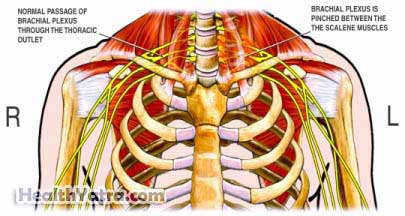Definition
Thoracic outlet syndrome (TOS) is a collective name for disorders that involve compression, injury, or irritation to nerves and blood vessels in the parts of the lower neck and upper chest called the “thoracic outlet.” These disorders are not all well understood and have little in common with one another, except that they occur in the same part of the body.
Causes
The cause of TOS will depend on the type of TOS:
- True neurologic TOS—caused by birth defects of vessels and nerves in the lower neck and upper chest.
- Arterial TOS—caused by birth defects of blood vessels in the lower neck and upper chest. There is no nerve damage or injury in this area.
- Venous TOS—exact cause is unknown. It is thought to be due to blockage the veins that drain the arm.
- Traumatic TOS—damage to vessels and nerves caused by an injury, such as a car accident.
- Disputed TOS (Common or Non-specific TOS)—cause is unknown, but may be related to accident or injury.
Symptoms
Symptoms can vary by type:
- True neurologic TOS will only have symptoms on one side of the body including:
- Hand weakness
- Numbness
- Raynaud’s phenomena (changing of the color of the limb when exposed to cold)
- Decreased size of hand muscles
- Arterial TOS may cause:
- Cold sensitivity in the hands and fingers
- Numbness
- Pain or sores of the fingers
- Poor blood circulation to the arm, hands, and fingers
- Venous TOS symptoms develop suddenly, often after a tiring arm exercise. Symptoms may include:
- Swelling of the limb
- Skin of arm turning pale and blue
- May be tingling of the fingers
- Traumatic TOS symptoms include:
- Pain and tingling and pricking of the neck, chest, and arms
- Numbness and weakness
- Disputed TOS symptoms include:
- Pain in the upper extremity
- Muscle weakness
- Fatigue
Risk Factors
These factors increase your chance of developing TOS. Tell your doctor if you have any of these risk factors:
- Sagging muscles related to aging
- Being obese
- Having heavy breasts
Other possible risk factors include:
- Sleep disorders
- Imbalanced blood levels of estrogen and/or thyroid hormone levels
- Rheumatoid arthritis
- Fibromyalgia
- Poor nutrition
- Anemia
- Infection
- Presence of tumors or large lymph nodes in the upper chest or underarm area
- Psychological stress or depression
TOS may also be caused by work activities, such as repetitive injuries from carrying heavy shoulder loads. This may lead to swelling of tendons and muscles in the shoulders and upper arms. Swelling may lead to TOC by compressing and damaging nerves and blood vessels in the neck and shoulders.
Diagnosis
Your doctor will ask about your symptoms and medical history, and perform a physical exam. So called “stress tests” are commonly employed in the diagnosis of TOS.
During these tests, your doctor will ask you to hold your arms and head in positions that may cause the TOS symptoms to reappear. The results of these tests will help determine whether you have TOS and rule out other possible related conditions.
Rarely, arteriography is used to evaluate TOS. This is an invasive procedure where dye is injected into the arteries to evaluate for any abnormalities. This may be used if a surgery is being planned to correct an arterial TOS.
Treatment
Treatment varies depending on the type of TOS. Surgery may successfully treat true neurologic TOS, vascular TOS, and some cases of traumatic TOS. The other types of TOS vary considerably in their response to nonsurgical treatment.
Pain medication, starting with nonsteroidal anti-inflammatory medications (eg, ibuprofen ), is usually the mainstay of therapy. In addition, physical therapy is often prescribed to strengthen the muscles of the neck and shoulders and help improve their flexibility.
Prevention
TOS is not preventable in many cases, though the risk for this problem can be reduced by avoiding:
- Repetitive injuries that come with carrying heavy weights
- Repeatedly reaching overhead
- Lifting objects with the arms extended above shoulder level.

